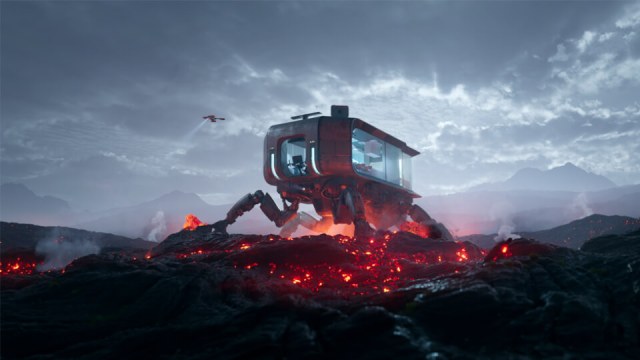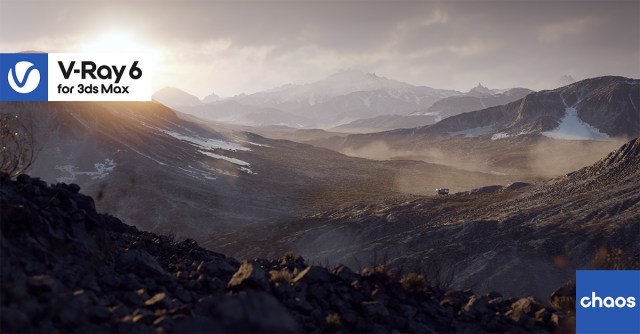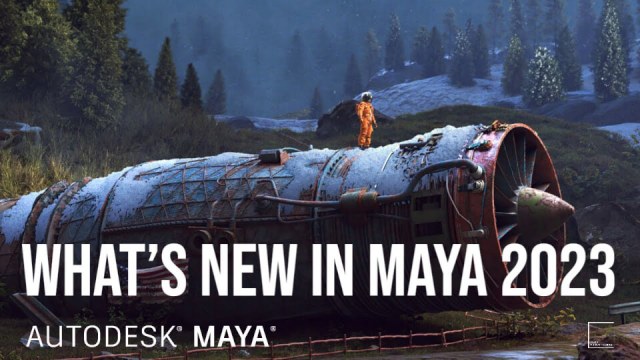V-Ray 6 for Maya packs in a number of powerful, new tools that enable users to create without limits. They can now generate complex surfaces for stunning close-up shots at no extra memory cost. Craft just the right sky for their environment in just a few clicks.
Take their product design and HDRI renders to the next level, and more. With V-Ray 6, users can also make use of Chaos Cloud Collaboration to fast-forward their projects’ reviews and approvals, as well as easily monitor and manage rendering performance with V-Ray Profiler. Plus, they can experience a number of other workflow enhancements including identical results from IPR and the production renderer, enhanced USD support, faster and more efficient rendering, background Chaos Cloud Rendering submissions and much more.
Key features in V-Ray 6 for Maya
Create without limits. Powerful, new tools allow you to build anything imaginable.
V-Ray Enmesh. Create complex surfaces with lots of detail for stunning close-up shots. With Enmesh, you can repeat geometry across the surface of an object at no extra memory cost. Start treating geometry like a texture, creating intricate chain mails, car grilles, metal grids, panels, fences, fabrics, and so much more.
Finite Dome light mode. Elevate your product design and HDRI environment renders with the new, more flexible ground projection capabilities of the V-Ray Dome Light. Set the scale of your light, and have full control over blend settings with the new Finite Dome mode.
Procedural clouds. Craft just the right cloudy sky for your environment in just a few clicks with V-Ray Sun and Sky’s new procedural clouds system. No need to settle for a static HDR or a cloudless sky. Now you can easily simulate a variety of cloud types and weather conditions, from partly cloudy to overcast. Render realistic stills or dynamic time-lapses.
V-Ray Decal with Displacement. You can now use V-Ray Decal to add displacement to any surface for even more realistic cracked walls, rocks, scratched and rusty surfaces, embossed lettering, and more.
Streamline your workflow. Fast-forward your project’s reviews and approvals.
Chaos Cloud Collaboration. Get rapid, consolidated feedback on your work’s progress. Upload your renders to Chaos Cloud Collaboration right from V-Ray’s Frame Buffer, and share your work with colleagues and clients to add comments and annotations, see panorama views and more — from anywhere in the world.
Easily monitor and manage rendering performance, and so much more.
V-Ray Profiler. Get reports on the time spent calculating shaders and volumes in your scenes. Locate all hot spots in your scene and optimize pipelines for even faster rendering. Pair V-Ray Profiler with the Memory Tracker, and you now have everything you need to monitor and optimize your projects.
Light Cache in IPR. Make better decisions while iterating on your designs with V-Ray’s Interactive Production Renderer (IPR) output now being identical to the production renderer.
Background Cloud Cloud submissions. You now have uninterrupted access to Maya when submitting to Chaos Cloud Rendering, so you can continue working.
Enhanced USD support. Experience a USD workflow that’s smoother than ever. We’ve added support for the latest MayaUSD version as well as included new enhancements for OpenVDB volumes and V-Ray material exports, promoting an easy exchange with Solaris and USD-powered pipelines.
Faster rendering. V-Ray Environment Fog now renders up to 30% faster. Translucent material rendering is also up to 2x faster thanks to V-Ray Material’s brand-new Illumination mode. Plus, scenes featuring thousands of instances now render more efficiently.
Shade faster and better. Speed up shading and create even more physically accurate materials.
Thin Film layer. Create realistic soap bubbles, oil spills and more with the new Thin Film option available in the V-Ray Material.
Enhanced V-Ray Material energy preservation. Render even more physically accurate rough metals and other reflective surfaces with enhanced V-Ray Material energy preservation.
Composition Guides Layer in VFB. Fine-tune your scenes’ compositions without going to a separate application. With customizable overlays, the new composition guides layer in the VFB allows you to easily experiment and enhance your image compositions.
VFB Panorama Viewer. Now you can preview your spherical panorama renders while rendering, right from your V-Ray Frame Buffer.
What’s new
V-Ray is the renderer that does it all, allowing users to create without limits. No need to switch applications and interrupt your creative process. Users can easily create complex surfaces with lots of detail for realistic close-up shots at no extra memory cost.
V-Ray 6 speeds up shading and allows users to create even more physically accurate reflective materials.
V-Ray 6 for Maya also enables users to easily monitor your scene’s shaders and volumes rendering performance and locate hot spots for optimization.
You now have a fast and efficient way to share your renders, collect feedback and collaborate with your team or customers. You can also create custom skies for their environments in just a few clicks and render powerful timelapse videos.
V-Ray 6 introduces a number of enhancements that streamline users’ workflows, including consistent results between IPR and the production renderer, enhanced USD support, faster and more efficient rendering, and more.
V-Ray 6 adds even more functionality to the V-Ray Frame Buffer and enables you to further streamline your workflow and make better decisions as you review your work.
Users can now render with V-Ray in any host application and benefit from the powerful suite of Chaos products and services with just a single license.
Buy V-Ray for Maya
To purchase visit the product page here.
Get in touch
Call us on +353 (0)1 526 6717 or email sales@bluegfx.eu









